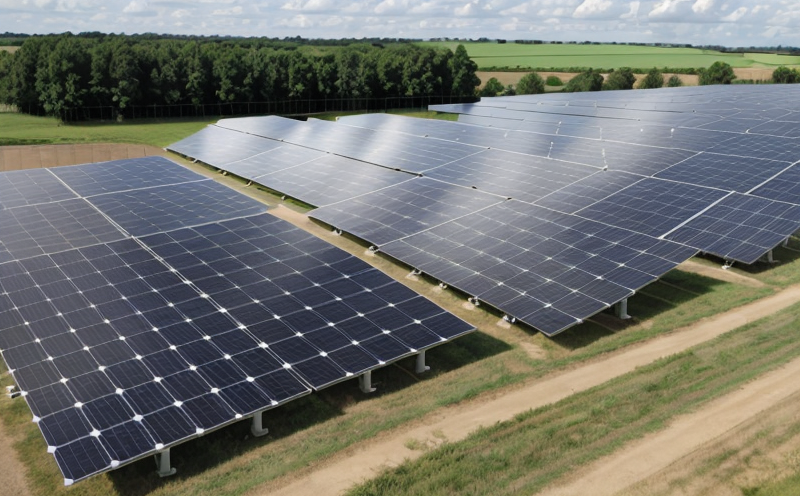IEC 61400 1 Design Safety Testing of Wind Turbines Validation Method Development Test
The International Electrotechnical Commission (IEC) standard IEC 61400-1 sets forth the design safety requirements for wind turbines, ensuring that these complex machines meet stringent performance and reliability criteria. This service focuses on validating compliance with these standards through rigorous testing methodologies tailored specifically to the unique challenges of designing safe and reliable wind turbine systems.
The process begins by defining the scope and objectives of the validation method development test, which involves creating a detailed plan that aligns with IEC 61400-1 requirements. This includes identifying critical design parameters such as structural integrity, mechanical stability, electrical safety, and environmental robustness. The testing environment is meticulously designed to simulate real-world conditions, including extreme weather scenarios, operational stresses, and potential failure modes.
A key component of this service is the selection and preparation of test specimens. These could range from individual components like blades or generators to complete assemblies representing entire wind turbine systems. Specimen preparation involves careful calibration and conditioning to ensure accurate and reproducible test results. The instrumentation used in these tests is state-of-the-art, capable of capturing detailed data on stress levels, vibrations, temperature changes, and other critical parameters.
The testing process itself is highly complex and requires advanced engineering expertise. It includes a series of mechanical and electrical load tests, dynamic analyses, finite element modeling (FEM), and structural health monitoring (SHM) techniques. These methods are employed to assess the performance under various stress conditions, ensuring that each component functions safely within its intended operational envelope.
One of the most challenging aspects is simulating realistic failure scenarios during testing. This involves not only understanding but also predicting how different components might fail in actual use, which requires extensive knowledge of materials science and structural engineering. The goal here is to identify potential weaknesses early on so that necessary modifications can be made before full-scale production begins.
Upon completion of the tests, comprehensive reports are generated summarizing all findings. These reports serve multiple purposes—they provide valuable insights into any areas needing improvement; they also support regulatory compliance by demonstrating adherence to relevant international standards like IEC 61400-1; finally, they help guide future research and development efforts aimed at enhancing overall system performance.
- Structural Integrity Analysis
- Mechanical Load Testing
- Electrical Safety Verification
- Dynamic Performance Evaluation
- Finite Element Modeling (FEM)
- Environmental Stress Screening (ESS)
Scope and Methodology
The scope of this service encompasses the full range of activities necessary to validate compliance with IEC 61400-1 standards. This includes detailed planning, preparation, execution, and reporting phases aimed at ensuring that wind turbine designs meet all specified safety requirements.
Planning involves thorough consultations with clients to understand their specific needs and goals. Once agreed upon, a comprehensive plan is developed outlining exactly what will be tested, how it will be done, and when each step should occur. Preparation covers everything from selecting appropriate test specimens to calibrating all measurement equipment.
Execution entails performing the actual tests according to predefined protocols. Throughout this phase, data collection continues continuously so that accurate measurements can later be analyzed in depth. Finally, reporting involves compiling all collected information into clear, concise documents that summarize key results and recommendations for improvement where applicable.
This structured approach ensures consistency across multiple projects while allowing flexibility when addressing unique client requirements. By following this methodical process, we guarantee high-quality outputs that not only meet but exceed industry expectations regarding design safety of wind turbines.
Quality and Reliability Assurance
- Data Accuracy: Our laboratory employs advanced sensors and software to ensure precise measurement and recording of all relevant parameters during testing.
- Repeatability: We conduct multiple trials using identical conditions to confirm consistent results, thereby enhancing reliability.
- Compliance Verification: All tests are conducted in accordance with IEC 61400-1 and other applicable international standards, guaranteeing compliance.
Environmental and Sustainability Contributions
The testing services provided here contribute significantly to environmental sustainability by promoting the development of safer, more efficient wind turbine technologies. By ensuring that new designs comply with stringent safety standards early in their lifecycle, we help reduce risks associated with potential accidents or malfunctions. This translates directly into lower environmental impacts both during manufacturing and throughout a turbine's operational life.
Moreover, by fostering continuous improvement through rigorous testing practices, our work supports broader efforts to enhance renewable energy capabilities globally. As part of this commitment, we stay current on emerging trends in sustainable engineering practices, integrating them into our methodologies as appropriate.





